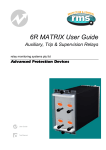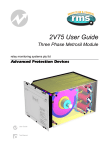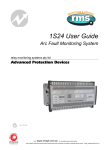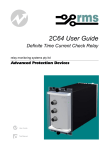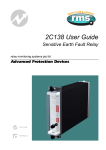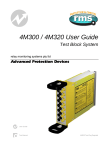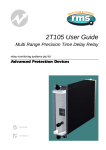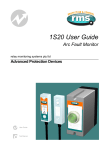Download 6RJ User Guide
Transcript
6RJ User Guide High Speed Tripping Relay relay monitoring systems pty ltd A dvanced Protection Devices User Guide Visit www.rmspl.com.au for the latest product information. Due to RMS continuous product improvement policy this information is subject to change without notice. 6RJ_Guide/Iss A/12/08/13 6RJ User Guide About This Manual This User Guide covers all 6RJ relays manufactured from October 2013. Earlier relays do not necessarily incorporate all the features described. Our policy of continuous development means that extra features & functionality may have been added. The 6RJ User Guide is designed as a generic document to describe the common operating parameters for all relays built on this platform. Some relay applications are described but for specific model information the individual “K” number Product / Test manuals should be consulted. The copyright and other intellectual property rights in this document, and in any model or article produced from it (and including any Registered or unregistered design rights) are the property of Relay Monitoring Systems Pty Ltd. No part of this document shall be reproduced or modified or stored in another form, in any data retrieval system, without the permission of Relay Monitoring Systems Pty Ltd, nor shall any model or article be reproduced from this document without consent from Relay Monitoring Systems Pty Ltd. While the information and guidance given in this document is believed to be correct, no liability shall be accepted for any loss or damage caused by any error or omission, whether such error or omission is the result of negligence or any other cause. Any and all such liability is disclaimed. Contact Us Relay Monitoring Systems Pty Ltd 2006-2013 6 Anzed Court • Mulgrave 3170 • AUSTRALIA Phone 61 3 8544 1200 • Fax 61 3 8544 1201 Email [email protected] • Web www.rmspl.com.au To download a PDF version of this guide: http://www.rmspl.com.au/userguide/6RJ_user_guide.pdf To download the model specific Product Test Manual: http://www.rmspl.com.au/search.asp Part 1 How this Guide is Organised This guide is divided into five parts: Part 1 Overview Part 2 Documentation Part 3 Application Part 4 Installation Preliminaries Part 5 Maintenance Visit www.rmspl.com.au for the latest product information.Page Due to RMS continuous product improvement policy this information is subject to change without notice. 6RJ_Guide/Iss A/12/08/13 Part 2 Documentation Technical Bulletin The detailed technical attributes, functional description & performance specifications for the 6RJ series are described in the product Technical Bulletins. For the most up to date version go to: www.rmspl.com.au/6rmatrix_pre_defined.htm The order of precedence for product information is as follows: Product Test Manual (PTM) Technical Bulletin User Guide User Guide This User Guide covers all 6RJ relay versions & describes the generic features & attributes common across all versions. Different relay versions are required to cater for varying customer requirements such as auxiliary voltage range, I/O configuration, case style, relay functionality etc. The product ordering code described in the Technical Bulletin is used to generate a unique version of the relay specification & is called a Type Number. This code takes the form 6RJKxx where the Kxx is the “K” or version number. For a complete description of the RMS “K” number system refer to: www.rmspl.com.au/handbook/parta3.pdf Product Test Manual Each 6RJ version has a specific PTM which provides details on the unique attributes of the relay. Each PTM includes the following information: Specific technical variations from the standard model if applicable Wiring diagram If you require a copy of the PTM for an RMS product the following options are available: Check the RMS web site at: www.rmspl.com.au/search.asp RMS CD catalogue select: List all Product/Test Manuals under Technical Library Contact RMS or a representative & request a hard copy or PDF by email. Visit www.rmspl.com.au for the latest product information.Page Due to RMS continuous product improvement policy this information is subject to change without notice. 6RJ_Guide/Iss A/12/08/13 Part 3 Application Introduction ..................................................................................................................... 4 Scheme Wiring ................................................................................................................ 5 5 Contact 6RJ Relay Connection diagram ............................................................................................ 5 10 Contact 6RJ Relay Connection diagram .......................................................................................... 6 20 Contact 6RJ Relay Connection diagram .......................................................................................... 7 6RJ34-10 Relay Connection diagram ................................................................................................... 8 6RJ34-20 Relay Connection diagram ................................................................................................... 9 Example Schematic – Typical Trip Application ................................................................................... 10 Terminal Layout and Relay Dimensions ............................................................................................. 11 5 or 10 Contact Relays ............................................................................................................................ 11 20 Contact Relays ................................................................................................................................... 12 6RJ Indications ............................................................................................................. 13 Front Layout ........................................................................................................................................ 13 Latched Contact Reset and Flag Reset Push Button.......................................................................... 13 Commissioning ............................................................................................................. 14 Commissioning Preliminaries .............................................................................................................. 14 Site Commissioning Verification Checklist .......................................................................................... 15 Preliminary Checks.................................................................................................................................. 15 Operate/Reset Operation ........................................................................................................................ 17 Protection Scheme Confirmation ............................................................................................................. 19 Page 3 Visit www.rmspl.com.au for the latest product information.Page Due to RMS continuous product improvement policy this information is subject to change without notice. 6RJ_Guide/Iss A/12/08/13 Introduction The 6RJ High Speed Trip relay is a withdrawable High Speed Tripping relay with low contact bounce time and high contact rating. High burden variants of 6RJ Relay allow for applications that have specific Capacitor Discharge Immunity requirements to ESI 48-4 EB2. The 6RJ high speed tripping relay is available in 5, 10 or 20 contact variants with either self resetting or latched contacts, hand reset and/or electrical reset contacts and hand reset and/or electrical reset flags. 6RJ Series High Speed Tripping Relays RMS Alstom 6RJ11-5 MVAJ11, MVAJ051 Functional Description 6RJ11-10 MVAJ11, MVAJ101 6RJ13-5 MVAJ13, MVAJ053 6RJ13-10 MVAJ13, MVAJ103 6RJ15-5 MVAJ15, MVAJ055 6RJ15-10 MVAJ15, MVAJ105 6RJ21-5 MVAJ21, MVAJ051 6RJ21-10 MVAJ21, MVAJ101 6RJ21-20 MVAJ201 6RJ23-5 MVAJ23, MVAJ053 6RJ23-10 MVAJ23, MVAJ103 Low burden high speed trip relay Self reset contacts Hand reset flag Low burden high speed trip relay Hand reset contacts & flag Low burden high speed trip relay Hand & electrical reset contacts Independent hand reset flag High burden high speed trip relay Self reset contacts Hand reset flag Contacts 5 5 20 High burden high speed trip relay Hand reset contacts & flag 10 6RJ24-10 MVAJ24, MVAJ104 6RJ25-20 MVAJ205 High burden high speed trip relay Electrical reset contacts Independent hand reset flag High burden high speed trip relay Hand & electrical reset contacts Independent hand reset flag 6RJ34-10 6RJ34-20 MVAJ34 2HSM509 2M28-S 2HSM512 2M28-S 2HSM520 4M56-S 5 5 MVAJ25, MVAJ105 2M28-S 10 20 6RJ25-10 2HSM504 10 MVAJ203 MVAJ204 2M28-S 5 MVAJ24, MVAJ054 MVAJ25, MVAJ055 2HSM502 10 6RJ24-5 6RJ25-5 Case 10 6RJ23-20 6RJ24-20 6R MATRIX 5 10 2HSM516 2HSM519 20 20 2M28-S 4M56-S 5 10 2M28-S 4M56-S 20 10 Bistable control relay 2HSM514 2M28-S 4M56-S NGTS 2.19 2M28-S 4M56-S The relays are ordered with customer nominated contact arrangements. Page 4 Visit www.rmspl.com.au for the latest product information.Page Due to RMS continuous product improvement policy this information is subject to change without notice. 6RJ_Guide/Iss A/12/08/13 Scheme Wiring 5 Contact 6RJ Relay Connection diagram * Reset fitted only on applicable models 6RJ15, 6RJ24 & 6RJ25 * Page 5 Visit www.rmspl.com.au for the latest product information.Page Due to RMS continuous product improvement policy this information is subject to change without notice. 6RJ_Guide/Iss A/12/08/13 10 Contact 6RJ Relay Connection diagram * * Reset fitted only on applicable models 6RJ15, 6RJ24 and 6RJ25 Refer to specific connection diagram for the 6RJ34-10 variants. Page 6 Visit www.rmspl.com.au for the latest product information.Page Due to RMS continuous product improvement policy this information is subject to change without notice. 6RJ_Guide/Iss A/12/08/13 20 Contact 6RJ Relay Connection diagram * Reset fitted only on applicable models 6RJ24 and 6RJ25 * Refer to specific connection diagram for the 6RJ34-20 variants. Page 7 Visit www.rmspl.com.au for the latest product information.Page Due to RMS continuous product improvement policy this information is subject to change without notice. 6RJ_Guide/Iss A/12/08/13 6RJ34-10 Relay Connection diagram Page 8 Visit www.rmspl.com.au for the latest product information.Page Due to RMS continuous product improvement policy this information is subject to change without notice. 6RJ_Guide/Iss A/12/08/13 6RJ34-20 Relay Connection diagram Page 9 Visit www.rmspl.com.au for the latest product information.Page Due to RMS continuous product improvement policy this information is subject to change without notice. 6RJ_Guide/Iss A/12/08/13 Example Schematic – Typical Trip Application + Main Protection Relay Electrical Reset 27 25 1 Reset Coil where specified Operate Coil 28 26 6RJ Trip Relay 2 52A Circuit Breaker Shown in the Open Position Circuit Breaker Trip coil Relays shown de-energised Page 10 Visit www.rmspl.com.au for the latest product information.Page Due to RMS continuous product improvement policy this information is subject to change without notice. 6RJ_Guide/Iss A/12/08/13 Terminal Layout and Relay Dimensions 5 or 10 Contact Relays in 2M28-S case 48 26 51 1 103 2 159 168 177 27 177 28 2 HOLES Ø3.7 Front View Back View 27 Cutout 217 25 157 13 MAX Side View 45 Top View 27 164 25 Page 11 Visit www.rmspl.com.au for the latest product information.Page Due to RMS continuous product improvement policy this information is subject to change without notice. 6RJ_Guide/Iss A/12/08/13 20 Contact Relays in 4M56-S case 48 03 26 103 1 159 168 99 52 1 2 1 1 27 28 2 HOLES Ø3.7 30 28 56 177 27 56 Back View 27 217 25 157 157 Side View 13 MAX 45 30 2 HOLES Ø3.7 4 HOLES Ø3.7 Cutout 25 1 159 168 159 168 27 4 HOLES Ø3.7 Front View 103 2 159 168 27 28 48 26 99 52 2 177 177 27 51 45 97 97 97 97 Top View 27 164 25 The relay module is designed for rack or panel mounting. Page 12 Visit www.rmspl.com.au 157 for the latest product information.Page Due to RMS continuous product improvement policy this information is subject to change without notice. 6RJ_Guide/Iss A/12/08/13 6RJ Indications Front Layout The figure below depicts the flag indication and the reset push button on the front the relay. Latched Contact Reset and Flag Reset Push Button Relays fitted with latched contacts may be reset via the Reset push button on relay models capable of hand or hand/electrical resetting. The flag drops upon operation of the relay. The Reset push button resets the flag on relay models with hand or hand/electrical reset flags. On relay models with Independent Hand reset flag, the electrical reset of the contacts does not reset the flag. This feature allows the flag indication to be maintained as a record of trip operation even if the contacts have been electrically reset by remote control or by an auto reclose scheme. Page 13 Visit www.rmspl.com.au for the latest product information.Page Due to RMS continuous product improvement policy this information is subject to change without notice. 6RJ_Guide/Iss A/12/08/13 Commissioning Commissioning Preliminaries Carefully examine the module to ensure that no damage has occurred during transit. Check that the model number and rating information are correct. Insulation The relay, and its associated wiring, may be insulation tested between: - all electrically isolated circuits - all circuits and earth An electronic or brushless insulation tester should be used, having a dc voltage not exceeding 1000V. Accessible terminals of the same circuit should first be strapped together. Deliberate circuit earthing links, removed for the tests, subsequently must be replaced. Injection Testing Testing of relay function may be undertaken using a secondary test set injecting directly into the relay operate coil or alternatively as part of a complete protection scheme tested in conjunction with the main protection relays. Page 14 Visit www.rmspl.com.au for the latest product information.Page Due to RMS continuous product improvement policy this information is subject to change without notice. 6RJ_Guide/Iss A/12/08/13 Site Commissioning Verification Checklist Observe all site specific standard safety procedures. The following tests are undertaken following the completion of all 6RJ relay wiring. Preliminary Checks Item 1 2 3 4 5 6 Description Complete Confirm all necessary primary equipment isolations Confirm all necessary secondary equipment isolations (including trip outputs) Check panel installation of the 6RJ relay Check the 6RJ relay is wired to the protection design schematic and the flag transit retainer has been removed With the relay element withdrawn from the case check for any evidence of transit damage and confirm free and easy movement of the armature assembly. Note : care should be taken to avoid touching the adjusted contacts or other relay internals. For latching models confirm that the relay contacts are able to be reset and the flag is reset (on independent flag reset models reset the contacts first and then the flag) Page 15 Visit www.rmspl.com.au for the latest product information.Page Due to RMS continuous product improvement policy this information is subject to change without notice. 6RJ_Guide/Iss A/12/08/13 Item 7 Description Complete To operate the relay contacts gently depress the armature mechanism using a blunt probe via the flag aperture taking care not to disturb any other relay internals Gently remove the blunt probe when the flag drops Page 16 Visit www.rmspl.com.au for the latest product information.Page Due to RMS continuous product improvement policy this information is subject to change without notice. 6RJ_Guide/Iss A/12/08/13 Item 8 9 10 11 Description Complete On latched contact models confirm that the armature mechanism latches when manually operated On latched contact models confirm that the latched contacts are able to be reset using the contact reset push button. Confirm that the fitted mechanical flags are able to be reset. In the non-operate state confirm the normally open and normally closed contact states against the relevant relay connection diagram using a suitable continuity tester Manually operate the relay contacts and confirm the contact state change against the relevant relay connection diagram using a suitable continuity tester Operate/Reset Operation Item 1 2 3 4 5 Description Complete Insert the relay module into the case and ensure contacts are reset and the mechanical flags are in the reset position The operate circuit is terminated to case terminals 27(+) and 28(-) Where fitted the electrical reset circuit is terminated to case terminals 25(+) and 26(-) Disconnect external wiring from these terminals to allow application of the test supply Check for operation of the operate circuit by energising the relay with 100% of the nominal supply voltage The test voltage is to be applied as a step The relays should switch cleanly with one movement On relays fitted with a mechanical flag, confirm that the flag drops to provide a visual indication of relay operation 6 7 Confirm the operate time of the contacts is in accordance with the relay technical bulletin With the relay in the operate state check the continuity of the closed contacts. The contact continuity test should be undertaken by applying 5A current & measuring the voltage across the closed output contact terminals Remove the operate circuit test supply Page 17 Visit www.rmspl.com.au for the latest product information.Page Due to RMS continuous product improvement policy this information is subject to change without notice. 6RJ_Guide/Iss A/12/08/13 Item 8 9 Description Complete On latching relays perform a manual contact reset and confirm the contact state change with a suitable continuity tester On relays fitted with a mechanical flag reset the flag On relays fitted with an electrical reset circuit, repeat steps 5 through to 7 Ensure that the operate circuit test supply is removed! Caution : failure to remove the operate circuit test supply for the following test will cause the reset coil to be damaged! Check for operation of the reset circuit by energising the reset input with 100% of the nominal supply voltage The test voltage is to be applied as a step and the relays should reset cleanly with one movement. Confirm the contact state change with a suitable continuity tester 10 On relays fitted with a mechanical flag reset the flag Restore any external wiring connections that may have been disturbed during the above tests Page 18 Visit www.rmspl.com.au for the latest product information.Page Due to RMS continuous product improvement policy this information is subject to change without notice. 6RJ_Guide/Iss A/12/08/13 Protection Scheme Confirmation Item 1 2 3 4 Description Complete With the tripping relay connected in the tripping scheme perform a trip check of the main protection relay Confirm intended operation of the tripping relay upon operation of the main protection relay On latching relays perform a manual contact reset and confirm the contact state change with a suitable continuity tester On relays fitted with a mechanical flag reset the flag On relays fitted with an electrical reset circuit, repeat steps 1 through to 2 Ensure that the operate circuit test supply is removed Check operation of the reset circuit by performing an electrical reset Confirm the contact state change with a suitable continuity tester On relays fitted with a mechanical flag reset the flag Page 19 Visit www.rmspl.com.au for the latest product information.Page Due to RMS continuous product improvement policy this information is subject to change without notice. 6RJ_Guide/Iss A/12/08/13 Part 4 Installation Handling of Electronic Equipment A person’s normal movements can easily generate electrostatic potentials of several thousand volts. Discharge of these voltages into semiconductor devices when handling electronic circuits can cause serious damage, which often may not be immediately apparent but the reliability of the circuit will have been reduced. The electronic circuits of Relay Monitoring Systems Pty Ltd products are immune to the relevant levels of electrostatic discharge when housed in the case. Do not expose them to the risk of damage by withdrawing modules unnecessarily. Each module incorporates the highest practicable protection for its semiconductor devices. However, if it becomes necessary to withdraw a module, the following precautions should be taken to preserve the high reliability and long life for which the equipment has been designed and manufactured. 1. Before removing a module, ensure that you are at the same electrostatic potential as the equipment by touching the case. 2. Handle the module by its front-plate, frame, or edges of the printed circuit board. 3. Avoid touching the electronic components, printed circuit track or connectors. 4. Do not pass the module to any person without first ensuring that you are both at the same electrostatic potential. Shaking hands achieves equipotential. 5. Place the module on an antistatic surface, or on a conducting surface which is at the same potential as yourself. 6. Store or transport the module in a conductive bag. If you are making measurements on the internal electronic circuitry of an equipment in service, it is preferable that you are earthed to the case with a conductive wrist strap. Wrist straps should have a resistance to ground between 500k – 10M ohms. If a wrist strap is not available, you should maintain regular contact with the case to prevent the build up of static. Instrumentation which may be used for making measurements should be earthed to the case whenever possible. Visit www.rmspl.com.au for the latest product information. Due to RMS continuous product improvement policy this information is subject to change without notice. User_Guide-4/IssE/25/08/08 Safety Section This Safety Section should be read before commencing any work on the equipment. The information in the Safety Section of the product documentation is intended to ensure that products are properly installed and handled in order to maintain them in a safe condition. It is assumed that everyone who will be associated with the equipment will be familiar with the contents of the Safety Section. Explanation of Symbols & Labels The meaning of symbols and labels which may be used on the equipment or in the product documentation, is given below. Caution: refer to product information Caution: risk of electric shock ! Functional earth terminal Note: this symbol may also be used for a protective/safety earth terminal if that terminal is part of a terminal block or sub-assembly eg. power supply. Visit www.rmspl.com.au for the latest product information. Due to RMS continuous product improvement policy this information is subject to change without notice. User_Guide-4/Iss E/25/08/08 Unpacking Upon receipt inspect the outer shipping carton or pallet for obvious damage. Remove the individually packaged relays and inspect the cartons for obvious damage. To prevent the possible ingress of dirt the carton should not be opened until the relay is to be used. Refer to the following images for unpacking the relay: Outer packing carton showing shipping documentation pouch. Address label on top of carton. Inner packing carton showing front label detailing the customer name, order number, relay part number & description, the relay job number & packing date. (Size 2 inner packing carton depicted) Visit www.rmspl.com.au for the latest product information. Due to RMS continuous product improvement policy this information is subject to change without notice. User_Guide-4/Iss E/25/08/08 Unpacking (Continued) Inner packing carton with lid open showing protective foam insert. CD depicted supplied with digital relay models or upon request at time of order. Inner packing carton with protective foam insert removed showing relay location. Where mechanical flags are fitted the yellow transit wedge must be removed before operation using a gentle twisting action. The wedge should be stored with the original packaging material. Visit www.rmspl.com.au for the latest product information. Due to RMS continuous product improvement policy this information is subject to change without notice. User_Guide-4/Iss E/25/08/08 Relay Module Side Label Depicting Product Details Relay Module Side Label Depicting Wiring Diagram Visit www.rmspl.com.au (6R MATRIX relays only) for the latest product information. Due to RMS continuous product improvement policy this information is subject to change without notice. User_Guide-4/Iss E/25/08/08 Accessories Supplied With Each Relay Self threading M4 mounting screws M4 terminal screws with captured lock washers Storage & Handling If damage has been sustained a claim should immediately be made against the carrier, also inform Relay Monitoring Systems Pty Ltd and the nearest RMS agent When not required for immediate use, the relay should be returned to its original carton and stored in a clean, dry place. Relays which have been removed from their cases should not be left in situations where they are exposed to dust or damp. This particularly applies to installations which are being carried out at the same time as constructional work. If relays are not installed immediately upon receipt they should be stored in a place free from dust and moisture in their original cartons. Dust which collects on a carton may, on subsequent unpacking, find its ay into the relay; in damp conditions the carton and packing may become impregnated with moisture and the dehumidifying agent will lose is efficiency. Visit www.rmspl.com.au for the latest product information. Due to RMS continuous product improvement policy this information is subject to change without notice. User_Guide-4/Iss E/25/08/08 Equipment Operating Conditions The equipment should be operated within the specified electrical and environmental limits. Protective relays, although generally of robust construction, require careful treatment prior to installation and a wise selection of site. By observing a few simple rules the possibility of premature failure is eliminated and a high degree of performance can be expected. Care must be taken when unpacking and installing the relays so that none of the parts are damaged or their settings altered and must al all times be handled by skilled persons only. Relays should be examined for any wedges, clamps, or rubber bands necessary to secure moving parts to prevent damage during transit and these should be removed after installation and before commissioning. The relay should be mounted on the circuit breaker or panel to allow the operator the best access to the relay functions. Relay Dimensions & Other Mounting Accessories Refer drawing in Technical Bulletin. Relevant Auto Cad files & details on other accessories such as 19 inch sub rack frames, semi projection mount kits & stud terminal kits may be down loaded from: http://www.rmspl.com.au/mseries.htm Visit www.rmspl.com.au for the latest product information. Due to RMS continuous product improvement policy this information is subject to change without notice. User_Guide-4/Iss E/25/08/08 Equipment Connections Personnel undertaking installation, commissioning or servicing work on this equipment should be aware of the correct working procedures to ensure safety. The product documentation should be consulted before installing, commissioning or servicing the equipment. Terminals exposed during installation, commissioning and maintenance may present hazardous voltage unless the equipment is electrically isolated. If there is unlocked access to the rear of the equipment, care should be taken by all personnel to avoid electric shock or energy hazards. Voltage and current connections should be made using insulated crimp terminations to ensure that terminal block insulation requirements are maintained for safety. To ensure that wires are correctly terminated, the correct crimp terminal and tool for the wire size should be used. Before energising the equipment it must be earthed using the protective earth terminal, or the appropriate termination of the supply plug in the case of plug connected equipment. Omitting or disconnecting the equipment earth may cause a safety hazard. The recommended minimum earth wire size is 2.5mm2, unless otherwise stated in the technical data section of the product documentation. Before energising the equipment, the following should be checked: 1. Voltage rating and polarity; 2. CT circuit rating and integrity of connections; 3. Protective fuse rating; 4. Integrity of earth connection (where applicable) Visit www.rmspl.com.au for the latest product information. Due to RMS continuous product improvement policy this information is subject to change without notice. User_Guide-4/Iss E/25/08/08 Current Transformer Circuits Do not open the secondary circuit of a live CT since the high voltage produced may be lethal to personnel and could damage insulation. External Resistors Where external resistors are fitted to relays, these may present a risk of electric shock or burns, if touched. Insulation & Dielectric Strength Testing Insulation testing may leave capacitors charged up to a hazardous voltage. At the end of each part of the test, the voltage should be gradually reduced to zero, to discharge capacitors, before the test leads are disconnected. Insertion of Modules These must not be inserted into or withdrawn from equipment whilst it is energised, since this may result in damage. Electrical Adjustments Pieces of equipment which require direct physical adjustments to their operating mechanism to change current or voltage settings, should have the electrical power removed before making the change, to avoid any risk of electric shock. Mechanical Adjustments The electrical power to the relay contacts should be removed before checking any mechanical settings, to avoid any risk of electric shock. Draw Out Case Relays Removal of the cover on equipment incorporating electromechanical operating elements, may expose hazardous live parts such as relay contacts. Insertion & Withdrawal of Heavy Current Test Plugs When using a heavy current test plug, CT shorting links must be in place before insertion or removal, to avoid potentially lethal voltages. Visit www.rmspl.com.au for the latest product information. Due to RMS continuous product improvement policy this information is subject to change without notice. User_Guide-4/Iss E/25/08/08 Commissioning Preliminaries Carefully examine the module and case to ser that no damage has occurred during transit. Check that the relay serial number on the module, case and cover are identical, and that the model number and rating information are correct. Carefully remove any elastic bands/packing fitting for transportation purposes. Check that the external wiring is correct to the relevant relay diagram or scheme diagram. The relay diagram number appears inside the case. Particular attention should be paid to the correct wiring and value of any external resistors indicated on the wiring diagram/relay rating information. Note that shorting switches shown on the relay diagram are fitted internally across the relevant case terminals and close when the module is withdrawn. It is essential that such switches are fitted across all CT circuits. If a test block system is to be employed, the connections should be checked to the scheme diagram, particularly that the supply connections are to the ‘live’ side of the test block. Earthing Ensure that the case earthing connection above the rear terminal block, is used to connect the relay to a local earth bar. Insulation The relay, and its associated wiring, may be insulation tested between: - all electrically isolated circuits - all circuits and earth An electronic or brushless insulation tester should be used, having a dc voltage not exceeding 1000V. Accessible terminals of the same circuit should first be strapped together. Deliberate circuit earthing links, removed for the tests, subsequently must be replaced. Visit www.rmspl.com.au for the latest product information. Due to RMS continuous product improvement policy this information is subject to change without notice. User_Guide-4/Iss E/25/08/08 Commissioning Tests If the relay is wired through a test block it is recommended that all secondary injection tests should be carried out using this block. Ensure that the main system current transformers are shorted before isolating the relay from the current transformers in preparation for secondary injection tests. DANGER DO NOT OPEN CIRCUIT THE SECONDAY CIRCUIT OF A CURRENT TRANSFORMER SINCE THE HIGH VOLTAGE PRODUCED MAY BE LETHAL AND COULD DAMAGE INSULATION. It is assumed that the initial preliminary checks have been carried out. Relay CT shorting switches With the relay removed from its case, check electrically that the CT shorting switch is closed. Primary injection testings It is essential that primary injection testing is carried out to prove the correct polarity of current transformers. Before commencing any primary injection testing it is essential to ensure that the circuit is dead, isolated from the remainder of the system and that only those earth connections associated with the primary test equipment are in position. Decommissioning & Disposal Decommissioning: The auxiliary supply circuit in the relay may include capacitors across the supply or to earth. To avoid electric shock or energy hazards, after completely isolating the supplies to the relay (both poles of any dc supply), the capacitors should be safely discharged via the external terminals prior to decommissioning. Disposal: It is recommended that incineration and disposal to water courses is avoided. The product should be disposed of in a safe manner. Visit www.rmspl.com.au for the latest product information. Due to RMS continuous product improvement policy this information is subject to change without notice. User_Guide-4/Iss E/25/08/08 Part 5 Maintenance Mechanical Inspection Relay Assembly Inspect the relay for obvious signs of damage or ingress of moisture or other contamination. Relay Module Isolate the relay, remove the front cover & carefully withdraw the relay module from the case. Care must be taken to avoid subjecting the relay element to static discharge which may damage or degrade sensitive electronic components. Inspect the relay module for signs of any overheating or burn marks which may have been caused by overvoltage surge or transient conditions on the power supply or digital status inputs. Inspect the VT & CT stages for degradation of insulation on the terminal wiring & transformer windings. Remove cover by unscrewing black thumb screws & withdraw the relay module from the case. Visit www.rmspl.com.au for the latest product information. Due to RMS continuous product improvement policy this information is subject to change without notice. User_Guide-5/Iss D/10/07/08 Relay Case Inspect the outer terminals checking insulation integrity & tightness. Inspect inside the case and use a blower to remove dust. Inspect the inner terminals for worn, distorted or tarnished contacts and if necessary clean the contacts using a brush dipped in a suitable substance. Case outer terminals Case inner terminals Module plug in terminals Test Intervals The maintenance tests required will largely depend upon experience and site conditions, but as a general rule it is recommended that the following inspection and tests are performed every twelve months. ♦ Mechanical Inspection ♦ Check of Connections ♦ Insulation Resistance Test ♦ Fault Setting Tests by Secondary Injection ♦ Tests using Load Current ♦ Check the continuity of the neutral CT loop with a bell test set or an ohmmeter Visit www.rmspl.com.au for the latest product information. Due to RMS continuous product improvement policy this information is subject to change without notice. User_Guide-5/Iss D/10/07/08 Defect Report Form Please copy this sheet and use it to report any defect which may occur. Customers Name & Address: Contact Name: Telephone No: Fax No: Supplied by: Date when installed: Site: Circuit: When Defect Found Date: Commissioning? Maintenance? Systems Fault? Product Part No: Other, Please State: Serial Number: Copy any message displayed by the relay: Describe Defect: Describe any other action taken: Signature: Please Print Name: Date: For RMS use only Date Received: Contact Name: Visit Reference No: www.rmspl.com.au Date Acknowledged: Date of Reply: Date Cleared: for the latest product information. Due to RMS continuous product improvement policy this information is subject to change without notice. User_Guide-5/Iss D/10/07/08 www.rmspl.com.au R e l a y M o n i t o r i n g Sy s t e m s P t y L t d d e s i g n , manufacture and market a wide range of electrical protection and control products for application on high voltage power systems. The company's depth of manufacturing and engineering expertise is backed up by many years of experience since the formation of its predecessor, Relays Pty Ltd (RPL), in 1955. This experience combined with a broad base of field proven product types enables RMS to service specific customer needs by producing relays on demand and with typically short lead times. R e l a y M o n i t o r i n g 6 Anzed Court Mulgrave, Victoria 3170 AUSTRALIA Ph: +61 3 8544 1200 Fax +61 3 8544 1201 Sales: [email protected] www.rmspl.com.au www.relays.com.au S y s t e m s P t y L t d ISO9001 Quality Accreditation RMS holds NCSI (NCS International Pty Limited) registration number 6869 for the certification of a quality system to AS/NZS ISO9001:2008. Due to RMS continuous product improvement policy the information contained in this document is subject to change without prior notice.




































